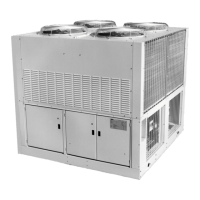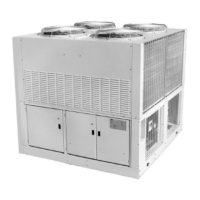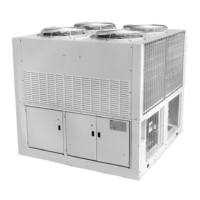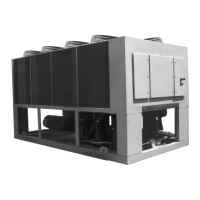12 AGZ 010B through 034B IOMM AGZB1
R-407C Units
AGZ chillers are available with R-407C refrigerant as non-ARI certified units. R-407C is a
zeotropic blend of three compounds, and as such exhibits the characteristic of glide. It does not
behave as one substance like R-22 does. Glide is the difference (in degrees F) between the
beginning and end phase-change process in either the evaporator or condenser. During these
processes, different ratios of the refrigerant’s components change phase from the beginning to the
end of the process. The following functions, conditions and settings will differ from units
charged with R-22.
1. Different physical data and electrical data
2. Polyolester lubricants are used instead of mineral oil.
3. The saturated pressure/temperature relationship
4. Control and alarm settings
5. Charging procedures
1. Lubrication. The units are factory-charged with polyoester (POE) lubricant and one of the
following lubricants must be used if lubricant is to be added to the system:
Copeland Ultra 22 CC
Mobil EAL Arctic 22 CC
ICI EMKARATE RL RL 32CF
POEs are very hygroscopic and will quickly absorb moisture if exposed to air. Pump the
lubricant into the unit through a closed transfer system. Avoid overcharging the unit.
2. Pressure/temperature relationship. See Table 3 on page 13 for the saturated pressure-
temperature chart. Due to refrigerant glide, use the following procedures for superheat and
subcooling measurement.
To determine superheat, only vapor must be present at the point of measurement, no liquid.
Use the temperature reading, the pressure reading and the Saturated P/T Chart. If the
pressure is measured at 78 psig, the chart shows the saturated vapor temperature to be
50.6°F. If the temperature is measured at 60°F, the superheat is 9.4 degrees F.
To determine subcooling, only liquid must be present, no vapor. Use the temperature
reading, the pressure reading and the Saturated P/T Chart. If the pressure is measured at
250 psig, the chart shows the saturated liquid temperature to be 108.2°F. If the temperature
is measured at 98°F, the subcooling is 10.2 degrees F.
The P/T relationship between R-407C and R-22 is similar enough to allow the use of R-22
expansion valves. The valves may be marked as “R-22’ or “R-22/R-407C”.
3. Control and alarm settings. The software that controls the operation of the unit is factory-
set for operation with R-407C, taking into account that the pressure/temperature relationship
differs from R-22. The software functionality is the same for either refrigerant.
4. Charging procedure. The units are factory-charged with R-407C. Use the following
procedure if recharging in the field is necessary:
Whether topping off a charge or replacing the circuit’s entire charge, always remove the
refrigerant from the charging vessel as a liquid. Many of the cylinders for the newer
refrigerants have a dip tube so that liquid is drawn off when the cylinder is in the upright
position. Do not vapor charge out of a cylinder unless the entire contents will be charged
into the system.
With the system in a 250-micron or lower vacuum, liquid can be charged into the high side.
Initially charge about 80 percent of the system total charge.

